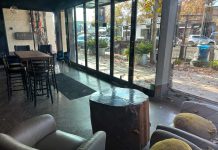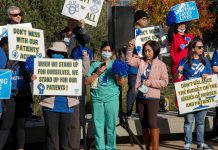My sister-in-law, Lue, is a member of the Daughters of the
American Revolution. A few weeks ago, when Lue and I were at
Michael’s, we ran into another Daughter, Romaine. Romaine and Lue
began to converse about their common interests, then stopped,
apologetically, self-deprecatingly, lest I should feel left out. I
remarked that my grandmother was a DAR member. Lue and Romaine
brightened, and invited me to go with their chapter to Gilroy Hot
Springs.
My sister-in-law, Lue, is a member of the Daughters of the American Revolution. A few weeks ago, when Lue and I were at Michael’s, we ran into another Daughter, Romaine. Romaine and Lue began to converse about their common interests, then stopped, apologetically, self-deprecatingly, lest I should feel left out. I remarked that my grandmother was a DAR member. Lue and Romaine brightened, and invited me to go with their chapter to Gilroy Hot Springs.
I had always been curious about Gilroy Hot Springs, so last Saturday I caravanned up Roop Road with the DAR to the south entrance of Henry Coe State Park, where we met state park ranger John Verhoeven, who handed us a two page synopsis of Hot Springs history, which I read as we drove on, over a truss bridge, through a gate which is normally locked, and one more mile to a flat where we parked.
The hot springs were probably known to the local Indians before being found by Francisco Cantua and Jose Ortega in the 1860’s. George Roop homesteaded the land in 1871, and in time built a hotel, cabins, a clubhouse, two restaurants, two swimming pools and private baths.
Improvements and attendance continued until the Great Depression, when the resort went into bankruptcy. HK Sakata, a Watsonville lettuce grower, bought it in 1939, just before he was interned for the duration of the War. He reopened in 1946, but could never make enough money on the place to finance maintenance. The resort was sold to a consortium with grandiose plans. Neighbors objected to the plans.
The hotel and clubhouse burned to the ground in 1980. The resort was sold to the state. The buildings are unsafe, and the state cannot afford to renovate them, so the area is closed to the public. Sigh.
We disembarked on the flat where the hotel once stood. John pointed out daisies in the grass and the ice house on the hill.
One of the Daughters saw a curious red insect, which John identified as a velvet ant, a flightless wasp. The Daughters proved to be excellent company on this field trip, full of questions and good cheer and enthusiasm. John proved to be an excellent ranger, full of information and enthusiasm and good cheer. It reminded me pleasantly of a homeschool fieldtrip.
We hiked up a trail between the remaining cabins. The land is beautiful; the cabins are marred with graffiti and in dangerous states of disrepair.
The highest, best maintained building is a small Shinto temple with the upturned beams of a pagoda. I peeked inside and saw recent offerings of an orange and incense. John explained that Mr. Sedo has retained permission to visit the site.
We continued our hike, traversing the hillside from riparian woodland to chaparral to meadow.
John showed us madrone and bay laurel, live oak and black oak, pyramid fern and maiden hair, ground irises, sticky monkey flower and blue-eyed grass, manzanita and chemise. We began to smell rotten eggs.
We reached another cluster of buildings: the gazebo and bathhouses. We saw a diesel generator, more cabins, one of which was pleasantly airy and light, and the former swimming pools, now filled with rocks and dirt for safety’s sake.
In the midst of the bathhouses, a pipe emerged from the ground. Water flowed from it; white deposits of hydrogen sulfide encrusted the ground of the creeklet thus formed.
The water was warm and smelly; John told us the temperature had been measured at 104 degrees. Near the pipe is a blue concrete basin, hot tub size. This is all that remains of the famous Gilroy Hot Springs.
It is a shame: state owned, public land, closed to the public because the state cannot afford to make the historical buildings safe. Henry Coe Sate Park and Mt. Madonna County Park contain tens of thousands of acres of beautiful California habitat, just like the area around the Springs. But in all that area, the Springs are unique.
I suggest we restore the Shinto temple, maintain the blue concrete basin, and raze the rest of the buildings. The area would be safe enough to reopen and the people of California could enjoy the Gilroy Hot Springs again.













